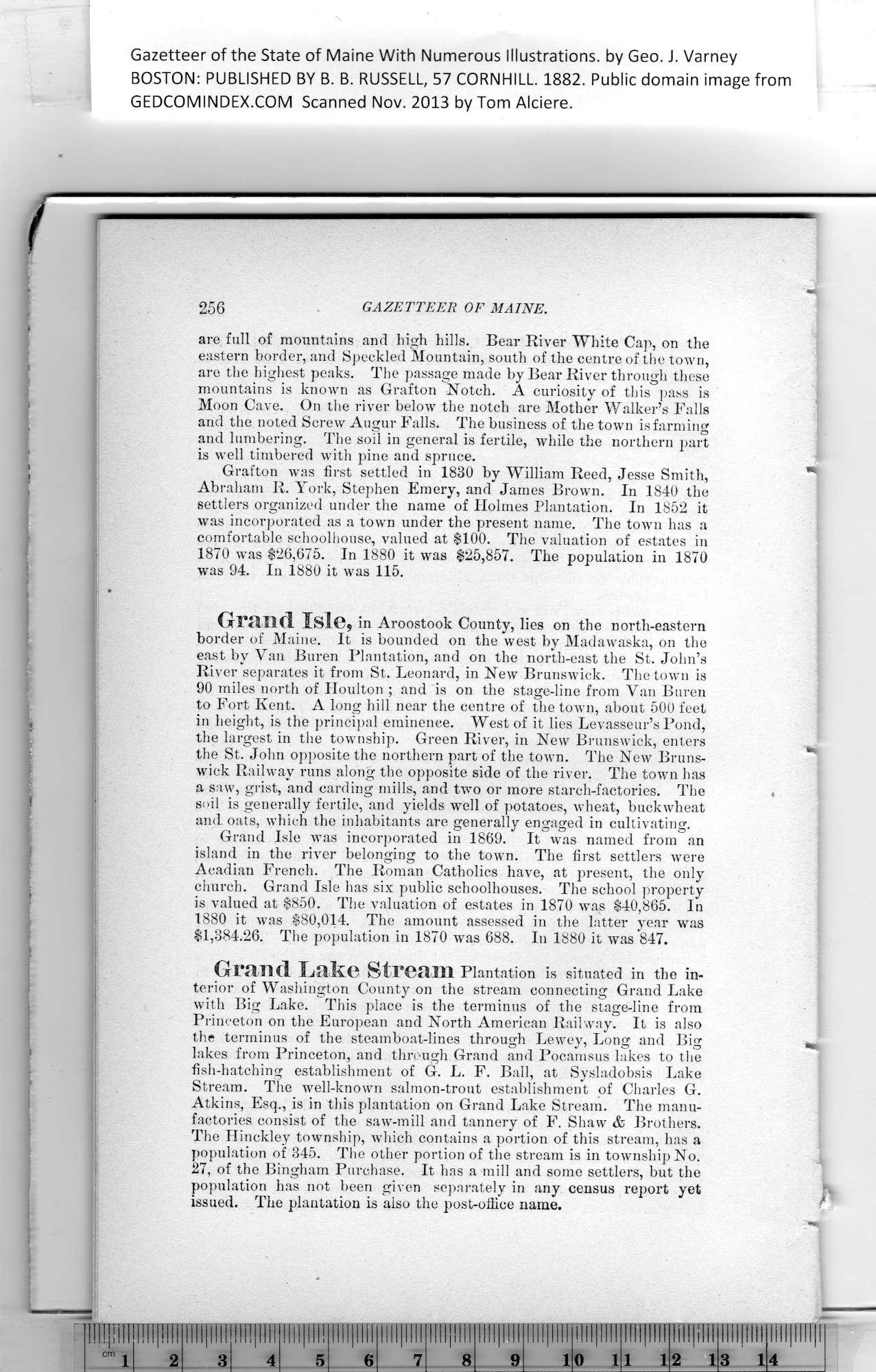|
Gazetteer of the State of Maine With Numerous Illustrations, by Geo. J. Varney
BOSTON: PUBLISHED BY B. B. RUSSELL, 57 CORNHILL. 1882. Public domain image from
256 GAZETTEER OF MAINE.
are full of mountains and high hills. Bear River White Cap, on the
eastern border, and Speckled Mountain, south of the centre of the town,
are the highest peaks. The passage made by Bear River through these
mountains is known as Grafton Notch. A curiosity of this pass is
Moon Cave. On the river below the notch are Mother Walker’s Falls
and the noted Screw Augur Falls. The business of the town is farming
and lumbering. The soil in general is fertile, while the northern part
is well timbered with pine and spruce.
Grafton was first settled in 1830 by William Reed, Jesse Smith,
Abraham R. York, Stephen Emery, and James Brown. In 1840 the
settlers organized under the name of Holmes Plantation. In 1852 it
was incorporated as a town under the present name. The town has a
comfortable schoolhouse, valued at $100. The valuation of estates in
1870 was $26,675. In 1880 it was $25,857. The population in 1870
was 94. In 1880 it was 115.
Grand Isle, in Aroostook County, lies on the north-eastern
border of Maine. It is bounded on the west by Madawaska, on the
east by Van Buren Plantation, and on the north-east the St.John’s
River separates it from St. Leonard, in New Brunswick. The town is
90 miles north of Houlton ; and is on the stage-line from Van Buren
to Fort Kent. A long hill near the centre of the town, about 500 feet
in height, is the principal eminence. West of it lies Levasseur’s Pond,
the largest in the township. Green River, in New Brunswick, enters
the St. John opposite the northern part of the town. The New Bruns-
wick Railway runs along the opposite side of the river. The town has
a saw, grist, and carding mills, and two or more starch-factories. The
soil is generally fertile, and yields well of potatoes, wheat, buckwheat
and oats, which the inhabitants are generally engaged in cultivating.
Grand Isle was incorporated in 1869. It was named from an
island in the river belonging to the town. The first settlers were
Acadian French. The Roman Catholics have, at present, the only
church. Grand Isle has six public schoolhouses. The school property
is valued at $850. The valuation of estates in 1870 was $40,865. In
1880 it was $80,014. The amount assessed in the latter year was
$1,384.26. The population in 1870 was 688. In 1880 it was 847.
Grand Lake Stream Plantation is situated in the in-
terior of Washington County on the stream connecting Grand Lake
with Big Lake. This place is the terminus of the stage-line from
Princeton on the European and North American Railway. It is also
the terminus of the steamboat-lines through Lewey, Long and Big
lakes from Princeton, and through Grand and Pocamsus lakes to the
fish-hatching establishment of G. L. F. Ball, at Sysladobsis Lake
Stream. The well-known salmon-trout establishment of Charles G.
Atkins, Esq., is in this plantation on Grand Lake Stream. The manu-
factories consist of the saw-mill and tannery of F. Shaw & Brothers.
The Hinckley township, which contains a portion of this stream, has a
population of 345. The other portion of the stream is in township No.
27, of the Bingham Purchase. It has a mill and some settlers, but the
population has not been given separately in any census report yet
issued. The plantation is also the post-office name.
PREVIOUS PAGE ... NEXT PAGE
This page was written in HTML using a program written in Python 3.2
|
